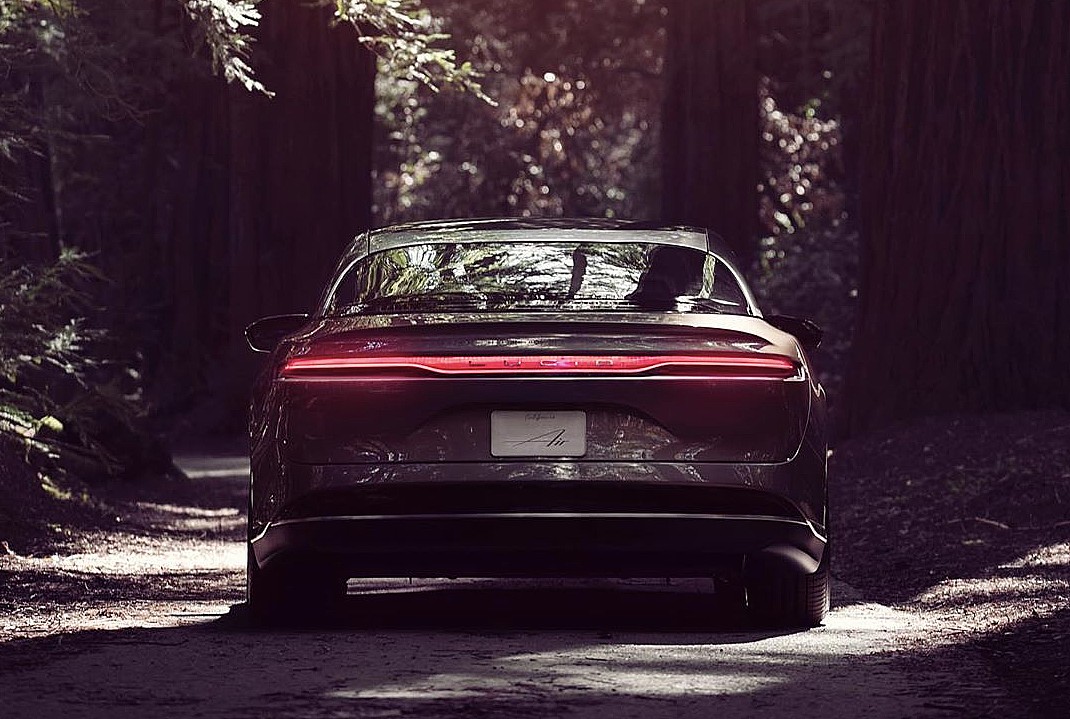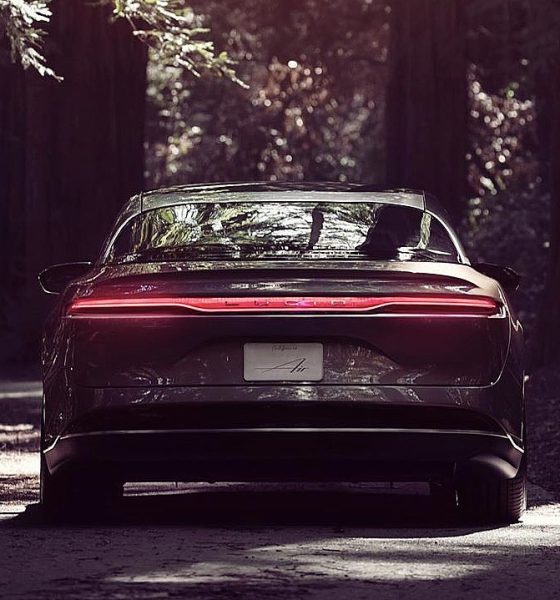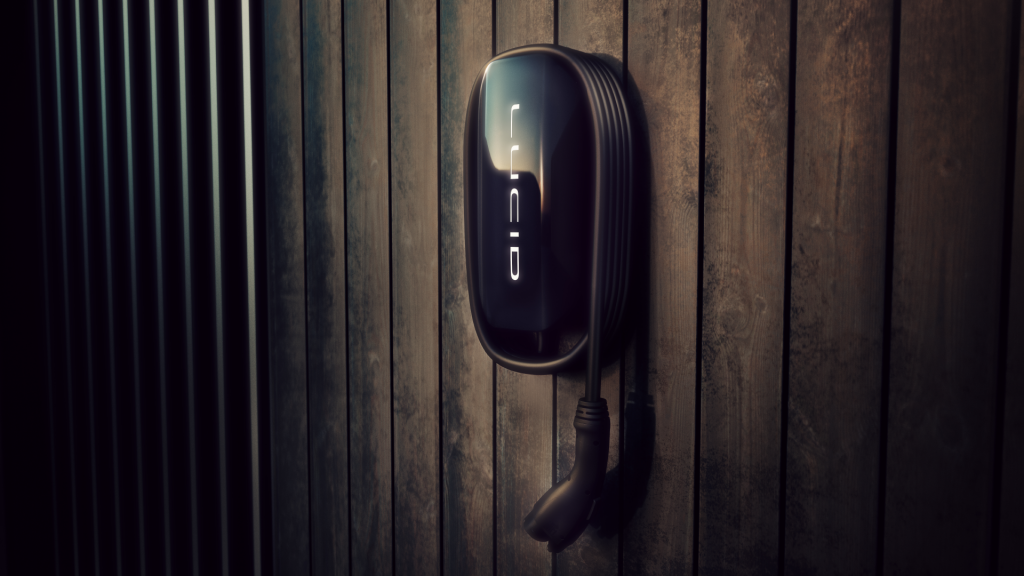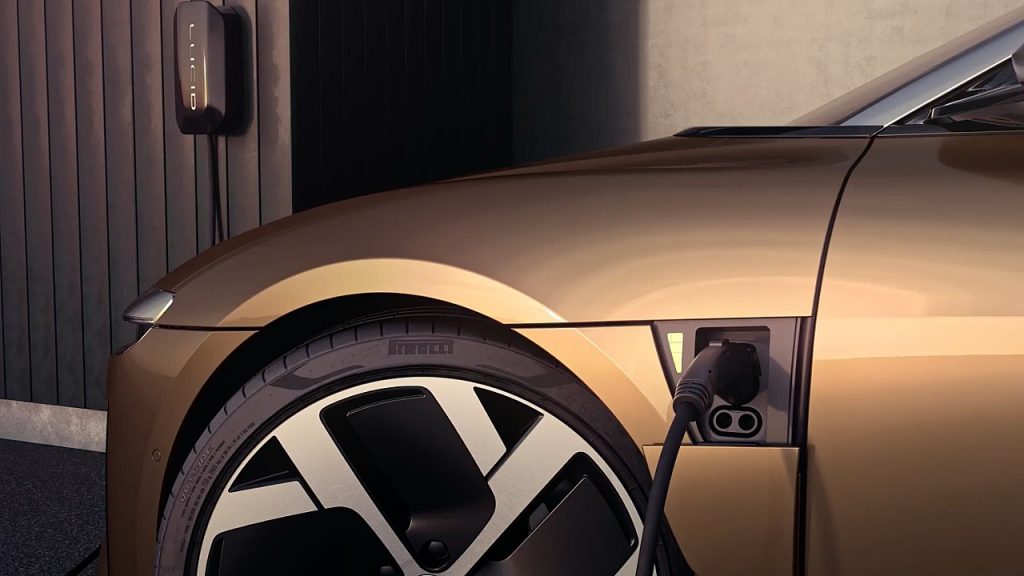

News
Lucid Air to offer vehicle-to-grid and vehicle-to-vehicle charging features
A recent press release from electric car maker Lucid Motors has revealed that the company will be rolling out its flagship Air sedan with a rather interesting feature: V2X. According to the company, “V2X” refers to “vehicle-to-everything,” which means that the Lucid Air will have full bi-directional capabilities built-in, allowing the car to function in both vehicle-to-grid (V2G) and vehicle-to-vehicle (V2V) scenarios.
As noted by the company in a press release, the Lucid Air’s bi-directional home charging capabilities could provide a lot of value to owners of the luxury electric sedan. Thanks to bi-directional charging, Lucid Air owners could utilize their vehicles as an energy storage unit to power their homes, which is particularly useful during those occasional trips to off-grid areas. The company described these features as follows.
“Home charging is one of the key benefits of EV ownership. In addition to the standard Lucid Mobile Charging Cord that comes with every Lucid vehicle, Lucid has also developed the Lucid Connected Home Charging Station, one of the first AC charging stations with bi-directional charging ever offered. With bi-directional charging, owners can enjoy not just a more cost-effective charging method, but also use their Lucid Air as a temporary energy reserve to power their homes, including off-grid vacation properties,” the company noted.

The rollout of the bi-directional Lucid Connected Home Charging Station is made possible by the EV maker’s integrated partnership with Qmerit. Owners of the Air who are interested in taking advantage of their vehicles’ bi-directional charging capabilities would be required to complete a digital survey, which Qmerit will then use to manage the installation process using its network of licensed electricians. Pricing for the Connected Home Charging Station is yet to be announced.
The Lucid Air’s vehicle-to-vehicle capabilities were not discussed by the company much in its recent press release, but the practical applications of the function are notable. With such a feature in place, Lucid Air owners would be able to provide power from their vehicles’ batteries to other electric cars that are low on energy. Interestingly enough, Lucid has not stated if its V2V capabilities will be universally compatible with other EVs, or if it is designed to work only between two Air sedans.

Vehicle-to-vehicle charging, while not yet mainstream, appears to be gaining ground in some territories. Just last year, for example, Hyundai launched India’s first V2V charging service, which allows owners with cars low on battery to call for another EV to be sent to their location. Once there, the recently-arrived electric car would be used as a power source for charging the customer’s vehicle.
The use of electric vehicles in V2G and V2V settings seems poised to spread in the near future. Earlier this year, reports emerged suggesting that industry leader Tesla is exploring vehicle-to-grid solutions for its growing fleet of vehicles, with noted Tesla hacker @greentheonly remarking that the company’s vehicles already have logic that allows DC to flow out of the company’s battery packs.
Interestingly enough, V2G is something that was discussed by former CTO JB Straubel, who noted back in 2015 that once there are a million Teslas on the road, the fleet could have substantial controllable load capacity. The 1-million-milestone was reached last March, and with Lucid offering “V2X” features right off the bat, it appears that the race to offer vehicle-to-grid services has just become a lot more interesting.

News
Tesla aims to combat common Full Self-Driving problem with new patent
Tesla writes in the patent that its autonomous and semi-autonomous vehicles are heavily reliant on camera systems to navigate and interact with their environment.

Tesla is aiming to combat a common Full Self-Driving problem with a new patent.
One issue with Tesla’s vision-based approach is that sunlight glare can become a troublesome element of everyday travel. Full Self-Driving is certainly an amazing technology, but there are still things Tesla is aiming to figure out with its development.
Unfortunately, it is extremely difficult to get around this issue, and even humans need ways to combat it when they’re driving, as we commonly use sunglasses or sun visors to give us better visibility.
Cameras obviously do not have these ways to fight sunglare, but a new patent Tesla recently had published aims to fight this through a “glare shield.”
Tesla writes in the patent that its autonomous and semi-autonomous vehicles are heavily reliant on camera systems to navigate and interact with their environment.

The ability to see surroundings is crucial for accurate performance, and glare is one element of interference that has yet to be confronted.
Tesla described the patent, which will utilize “a textured surface composed of an array of micro-cones, or cone-shaped formations, which serve to scatter incident light in various directions, thereby reducing glare and improving camera vision.”

The patent was first spotted by Not a Tesla App.
The design of the micro-cones is the first element of the puzzle to fight the excess glare. The patent says they are “optimized in size, angle, and orientation to minimize Total Hemispherical Reflectance (THR) and reflection penalty, enhancing the camera’s ability to accurately interpret visual data.”
Additionally, there is an electromechanical system for dynamic orientation adjustment, which will allow the micro-cones to move based on the angle of external light sources.
This is not the only thing Tesla is mulling to resolve issues with sunlight glare, as it has also worked on two other ways to combat the problem. One thing the company has discussed is a direct photon count.
CEO Elon Musk said during the Q2 Earnings Call:
“We use an approach which is direct photon count. When you see a processed image, so the image that goes from the sort of photon counter — the silicon photon counter — that then goes through a digital signal processor or image signal processor, that’s normally what happens. And then the image that you see looks all washed out, because if you point the camera at the sun, the post-processing of the photon counting washes things out.”
Future Hardware iterations, like Hardware 5 and Hardware 6, could also integrate better solutions for the sunglare issue, such as neutral density filters or heated lenses, aiming to solve glare more effectively.
Elon Musk
Delaware Supreme Court reinstates Elon Musk’s 2018 Tesla CEO pay package
The unanimous decision criticized the prior total rescission as “improper and inequitable,” arguing that it left Musk uncompensated for six years of transformative leadership at Tesla.

The Delaware Supreme Court has overturned a lower court ruling, reinstating Elon Musk’s 2018 compensation package originally valued at $56 billion but now worth approximately $139 billion due to Tesla’s soaring stock price.
The unanimous decision criticized the prior total rescission as “improper and inequitable,” arguing that it left Musk uncompensated for six years of transformative leadership at Tesla. Musk quickly celebrated the outcome on X, stating that he felt “vindicated.” He also shared his gratitude to TSLA shareholders.
Delaware Supreme Court makes a decision
In a 49-page ruling Friday, the Delaware Supreme Court reversed Chancellor Kathaleen McCormick’s 2024 decision that voided the 2018 package over alleged board conflicts and inadequate shareholder disclosures. The high court acknowledged varying views on liability but agreed rescission was excessive, stating it “leaves Musk uncompensated for his time and efforts over a period of six years.”
The 2018 plan granted Musk options on about 304 million shares upon hitting aggressive milestones, all of which were achieved ahead of time. Shareholders overwhelmingly approved it initially in 2018 and ratified it once again in 2024 after the Delaware lower court struck it down. The case against Musk’s 2018 pay package was filed by plaintiff Richard Tornetta, who held just nine shares when the compensation plan was approved.
A hard-fought victory
As noted in a Reuters report, Tesla’s win avoids a potential $26 billion earnings hit from replacing the award at current prices. Tesla, now Texas-incorporated, had hedged with interim plans, including a November 2025 shareholder-approved package potentially worth $878 billion tied to Robotaxi and Optimus goals and other extremely aggressive operational milestones.
The saga surrounding Elon Musk’s 2018 pay package ultimately damaged Delaware’s corporate appeal, prompting a number of high-profile firms, such as Dropbox, Roblox, Trade Desk, and Coinbase, to follow Tesla’s exodus out of the state. What added more fuel to the issue was the fact that Tornetta’s legal team, following the lower court’s 2024 decision, demanded a fee request of more than $5.1 billion worth of TSLA stock, which was equal to an hourly rate of over $200,000.
Delaware Supreme Court Elon Musk 2018 Pay Package by Simon Alvarez
News
Tesla Cybercab tests are going on overdrive with production-ready units
Tesla is ramping its real-world tests of the Cybercab, with multiple sightings of the vehicle being reported across social media this week.

Tesla is ramping its real-world tests of the Cybercab, with multiple sightings of the autonomous two-seater being reported across social media this week. Based on videos of the vehicle that have been shared online, it appears that Cybercab tests are underway across multiple states.
Recent Cybercab sightings
Reports of Cybercab tests have ramped this week, with a vehicle that looked like a production-ready prototype being spotted at Apple’s Visitor Center in California. The vehicle in this sighting was interesting as it was equipped with a steering wheel. The vehicle also featured some changes to the design of its brake lights.
The Cybercab was also filmed testing at the Fremont factory’s test track, which also seemed to involve a vehicle that looked production-ready. This also seemed to be the case for a Cybercab that was spotted in Austin, Texas, which happened to be undergoing real-world tests. Overall, these sightings suggest that Cybercab testing is fully underway, and the vehicle is really moving towards production.
Production design all but finalized?
Recently, a near-production-ready Cybercab was showcased at Tesla’s Santana Row showroom in San Jose. The vehicle was equipped with frameless windows, dual windshield wipers, powered butterfly door struts, an extended front splitter, an updated lightbar, new wheel covers, and a license plate bracket. Interior updates include redesigned dash/door panels, refined seats with center cupholders, updated carpet, and what appeared to be improved legroom.
There seems to be a pretty good chance that the Cybercab’s design has been all but finalized, at least considering Elon Musk’s comments at the 2025 Annual Shareholder Meeting. During the event, Musk confirmed that the vehicle will enter production around April 2026, and its production targets will be quite ambitious.








